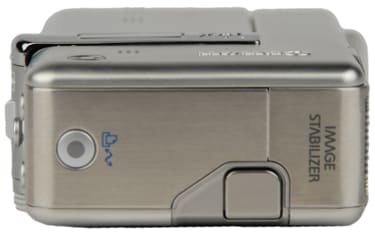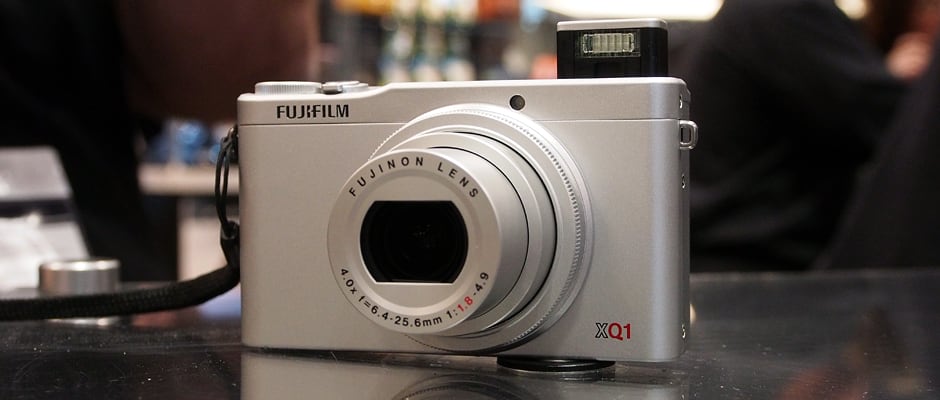Pros
Cons
Our First Take
Nevertheless, the controls were finicky and the image quality—while certainly good—didn't blow us out of the water. For those who care about image quality over style, the XF1 simply never stood a chance against the mighty Sony RX100.
Now the company has gone back to the drawing board and come up with the XQ1 (MSRP $499.99), a similarly tiny camera that ditches the awkward zoom ring and brings Fuji's top-tier X-Trans sensor tech down to the 2/3-inch sensor size. The result is a pocketable camera that should pack a real photographic punch.

Design & Usability
A more refined (if less distinctive) design
Like the XF1 before it, the XQ1 is supremely pocketable—right along the lines of the Canon PowerShot S120 and Nikon Coolpix P330. It's also well built, with a metal body and a super smooth control ring around the lens. The detailing on the camera is beautiful, from the bright silver finish (which leans more toward white than previous Fuji models) to the finely knurled ring and brushed metal mode dial. Unlike the XF1, this really feels like a premium camera.
The control ring is one of the biggest changes from the XF1, replacing the somewhat confusing and flimsy combined power switch/manual zoom ring that was the older camera's trademark. Within the XQ1's E-Fn menu (more on that later), you can assign virtually any vital shooting function to the lens ring, from exposure compensation, to manual focus, aperture, and so on. The ring is well-damped, and it's easy to use with a good degree of precision.
The rear control scheme is strictly stock, with a four-way control pad/rotary dial flanked by four more buttons. There's a physical mode dial up top (always a nice addition), along with a cute pop-up flash. The only real innovation is another feature that made its debut on the XF1: the E-Fn menu.

Pressing the E-Fn button (located at the bottom right of the rear control cluster) brings up an on-screen overlay showing alternative functions for most buttons, each of which can be programmed by the user. In effect, this doubles the number of direct controls you have access to, making the XQ1 behave more like a DSLR than a pocket cam. Of course, you need an extra press to get there—ain't no such thing as a free lunch.
There's no touchscreen, but the 3-inch rear display is quite bright and sharp, making it easy to both frame and review your shots. We didn't notice any lag on the somewhat dim Photo Plus Expo show floor—except when using the E-Fn menu, which seemed to cut the otherwise smooth refresh rate in half.
{{gallery "FI"}}
Features
An X20 you can put in your pocket
When we asked a Fujifilm booth rep if we ought to think of the XQ1 as an XF1 on steroids, he said it was more like an X20 in an entirely new form factor. To us, those are two sides of the same coin, but it's easy to see what he was getting at: The XQ1 has the same 2/3-inch X-Trans II sensor found in Fuji's rangefinder-style compact, along with its EXR Processor II. That's some serious horsepower for such a small camera—a bit like putting a V8 in a Mazda Miata.
Paired with the sensor and processor is an optically stabilized 4x zoom lens (25-100mm equivalent). That's a pretty conservative range, but like its competitors from Canon and Sony, the XQ1 offers a very wide aperture (f/1.8) on the wide end. Unfortunately, it also follows suit with a much narrower aperture at full telephoto (f/4.9). It's worth noting that this is the exact same lens found in the XF1, which we thought performed admirably. Paired with the X-Trans sensor, it's a lens that should be capable of great things.
One of the big advantages of moving to an X-Trans sensor is the inclusion of phase-detect pixels on the chip. The XQ1's hybrid autofocus configuration allows it to take advantage of contrast detection's superb speed and accuracy with still objects, while also getting the benefit of phase detection's tracking capabilities. We found the camera's AF to be extremely quick and accurate, even in questionable light. It's a big advantage over direct competitors.
Like most 2013 cameras, the XQ1 also throws in on-board WiFi connectivity. It's a pretty simplistic implementation: You can install apps on your smartphone and PC to receive photos from the camera via the camera's own (unsecured) WiFi network. On the one hand, it's pretty much as easy as these things get, but it's also a far cry from the more robust feature sets—complete with remote viewfinder capability and social sharing—that you get from Panasonic, Olympus, and Sony.
Software-wise, you still get all of Fujifilm's excellent Film Simulations, which strive to mimic the look of the company's legacy film stocks—Provia, Velvia, Astia, and so on. You also get a full complement of scene modes, art filters, and advanced shooting tools (like panoramas, software-enhanced background blur, and multi-shot noise reduction).
Unusually for a camera of this size and price point, the XQ1 also offers 1080/60p recording in the H.264 codec. Fuji's video efforts have been extremely underwhelming, historically speaking, so we're curious to see how the XQ1's clips turn out in our tests.
Conclusion
A plucky new rival steps into the ring
We felt last year's XF1 had potential, though we found ourselves irritated by some of its odd design choices. The XQ1 tames most of those quirks, upgrades the internals, adds a great new lens ring, and keeps the price right where it was. We think it's a great overall package, and it should be a serious new rival to cameras like the Canon S120 and even the Sony RX100.

At $500, Fujifilm is asking more of your wallet than most of its competitors; the S120, for instance, has an MSRP of $449.99, while the Nikon P330 is currently selling for just $300. But the XQ1 is a decidedly more premium camera than Canon's or Nikon's efforts—both in terms of its build and the quality of technology the company has thrown into it—and it's still a fair bit cheaper and slimmer than the elder RX100. If Fujifilm can get the public to take note, the XQ1 deserves to be in the conversation for any shopper in this market space.
Meet the tester
Ben is an experienced industry journalist who formerly served as Senior Editor of News and Features at Reviewed. He now contributes as a freelance writer and editor. Most recently hailing from the vast wilds of the American southwest, he is an avid photographer who is deeply disturbed by the lack of wide open landscapes in Boston.
Checking our work.
Our team is here to help you buy the best stuff and love what you own. Our writers, editors, and experts obsess over the products we cover to make sure you're confident and satisfied. Have a different opinion about something we recommend? Email us and we'll compare notes.
Shoot us an email

